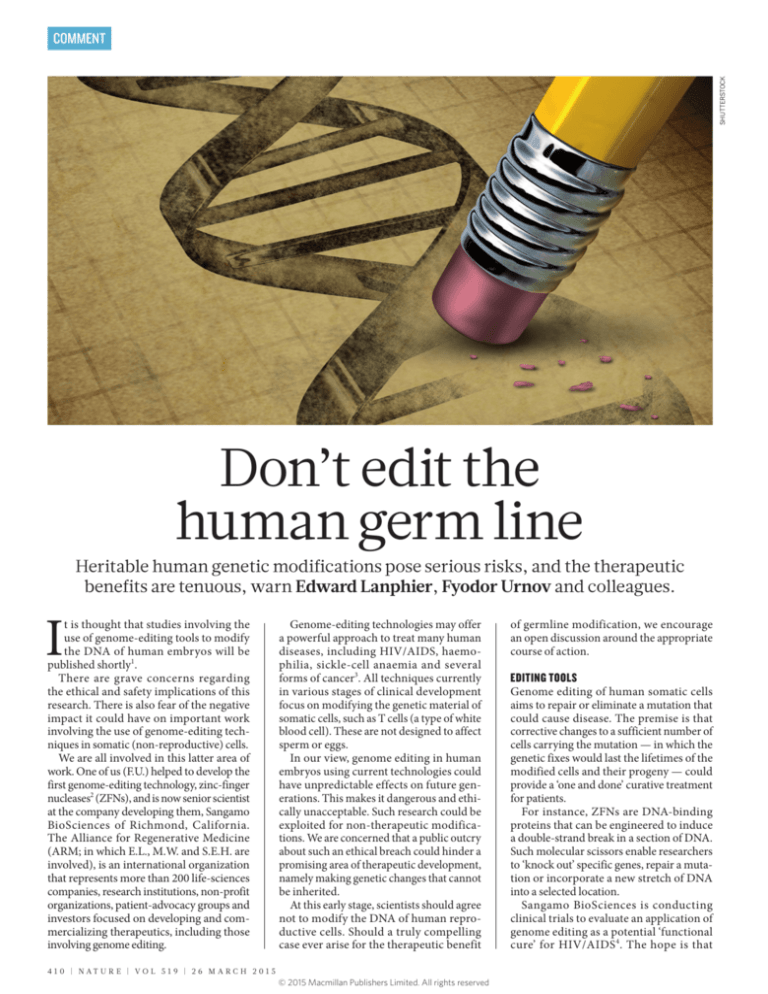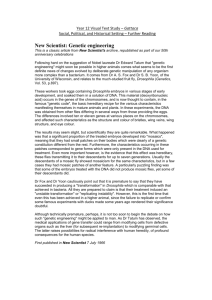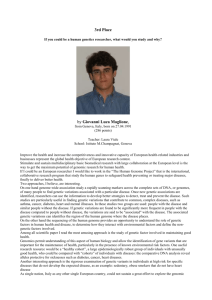
SHUTTERSTOCK
COMMENT
Don’t edit the
human germ line
Heritable human genetic modifications pose serious risks, and the therapeutic
benefits are tenuous, warn Edward Lanphier, Fyodor Urnov and colleagues.
I
t is thought that studies involving the
use of genome-editing tools to modify
the DNA of human embryos will be
published shortly1.
There are grave concerns regarding
the ethical and safety implications of this
research. There is also fear of the negative
impact it could have on important work
involving the use of genome-editing techniques in somatic (non-reproductive) cells.
We are all involved in this latter area of
work. One of us (F.U.) helped to develop the
first genome-editing technology, zinc-finger
nucleases2 (ZFNs), and is now senior scientist
at the company developing them, Sangamo
BioSciences of Richmond, California.
The Alliance for Regenerative Medicine
(ARM; in which E.L., M.W. and S.E.H. are
involved), is an international organization
that represents more than 200 life-sciences
companies, research institutions, non-profit
organizations, patient-advocacy groups and
investors focused on developing and commercializing therapeutics, including those
involving genome editing.
Genome-editing technologies may offer
a powerful approach to treat many human
diseases, including HIV/AIDS, haemophilia, sickle-cell anaemia and several
forms of cancer3. All techniques currently
in various stages of clinical development
focus on modifying the genetic material of
somatic cells, such as T cells (a type of white
blood cell). These are not designed to affect
sperm or eggs.
In our view, genome editing in human
embryos using current technologies could
have unpredictable effects on future generations. This makes it dangerous and ethically unacceptable. Such research could be
exploited for non-therapeutic modifications. We are concerned that a public outcry
about such an ethical breach could hinder a
promising area of therapeutic development,
namely making genetic changes that cannot
be inherited.
At this early stage, scientists should agree
not to modify the DNA of human reproductive cells. Should a truly compelling
case ever arise for the therapeutic benefit
4 1 0 | NAT U R E | VO L 5 1 9 | 2 6 M A RC H 2 0 1 5
© 2015 Macmillan Publishers Limited. All rights reserved
of germline modification, we encourage
an open discussion around the appropriate
course of action.
EDITING TOOLS
Genome editing of human somatic cells
aims to repair or eliminate a mutation that
could cause disease. The premise is that
corrective changes to a sufficient number of
cells carrying the mutation — in which the
genetic fixes would last the lifetimes of the
modified cells and their progeny — could
provide a ‘one and done’ curative treatment
for patients.
For instance, ZFNs are DNA-binding
proteins that can be engineered to induce
a double-strand break in a section of DNA.
Such molecular scissors enable researchers
to ‘knock out’ specific genes, repair a mutation or incorporate a new stretch of DNA
into a selected location.
Sangamo BioSciences is conducting
clinical trials to evaluate an application of
genome editing as a potential ‘functional
cure’ for HIV/AIDS 4. The hope is that
COMMENT
intravenous infusion of modified T cells
will enable patients to stop taking antiretroviral drugs. A phase I trial in patients
with β-thalassaemia — a genetic blood
disorder caused by insufficient haemoglobin production — is scheduled to begin
this year.
The newest addition to the genomeediting arsenal is CRISPR/Cas9, a bacteriaderived system that uses RNA molecules that
recognize specific human DNA sequences.
The RNAs act as guides, matching the nuclease to corresponding locations in the human
genome. CRISPR/Cas9 is the simplest
genome-editing tool to work with because
it relies on RNA–DNA base pairing, rather
than the engineering of proteins that bind
particular DNA sequences.
The CRISPR technique has dramatically expanded research on genome editing. But we cannot imagine a situation in
which its use in human embryos would
offer a therapeutic benefit over existing
and developing methods. It would be difficult to control exactly how many cells are
modified. Increasing the dose of nuclease
used would increase the likelihood that the
mutated gene will be corrected, but also
raise the risk of cuts being made elsewhere
in the genome.
In an embryo, a nuclease may not
necessarily cut both copies of the target
gene, or the cell may start dividing before
the corrections are complete, resulting in a
genetic mosaic. Studies using gene-editing
in animals such as rats5, cattle6, sheep7 and
pigs8, indicate that it is possible to delete or
disable genes in an embryo — a simpler process than actually correcting DNA sequences
— in only some of the cells.
The current ability to perform quality
controls on only a subset of cells means that
the precise effects of genetic modification
to an embryo may be impossible to know
until after birth. Even then, potential problems may not surface for years. Established
methods, such as standard prenatal genetic
diagnostics or in vitro fertilization (IVF)
with the genetic profiling of embryos before
implantation, are much better options for
parents who both carry the same mutation
for a disease.
LEGAL CASE
Patient safety is paramount among the
arguments against modifying the human
germ line (egg and sperm cells). If a mosaic
embryo is created, the embryo’s germ line
may or may not carry the genetic alteration. But the use of CRISPR/Cas9 in human
embryos certainly makes onward human
germline modification a possibility. Philosophically or ethically justifiable applications for this technology — should any ever
exist — are moot until it becomes possible
to demonstrate safe outcomes and obtain
reproducible data over multiple generations.
Because of such concerns — as well as
for serious ethical reasons — some countries discouraged or prohibited this type of
research a decade before the technical feasibility of germline modification was confirmed in rats in 2009 (ref. 9). (Today, around
40 countries discourage or ban it.)
Many countries do not have explicit
legislation in place permitting or forbidding
genetic engineering in humans — considering such research experimental and not
therapeutic (see go.nature.com/uvthmu).
However, in nations with policies regarding
inheritable genetic modification, it has been
prohibited by law or
by measures having “The precise
effects of
the force of law.
This consensus is genetic
most visible in west- modification
ern Europe, where to an embryo
15 of 22 nations pro- may be
hibit the modifica- impossible
tion of the germ line4. to know until
Although the United after birth.”
States has not officially prohibited germline modification, the
US National Institutes of Health’s Recombinant DNA Advisory Committee explicitly
states that it “will not at present entertain
proposals for germ line alterations” (see
go.nature.com/mgscb2).
In general, researchers who want to investigate the clinical uses of genetically engineered somatic cells must secure people’s
informed consent. In the United States, this
takes place under the oversight of the Food
and Drug Administration and the Department of Health and Human Services. For
research involving genetic modification of
the germ line, it is unclear what information would be needed — or obtainable — to
adequately inform prospective parents of the
risks, including to future generations.
Many oppose germline modification on
the grounds that permitting even unambiguously therapeutic interventions could start us
down a path towards non-therapeutic genetic
enhancement. We share these concerns.
Such discussions must include the public as
well as experts and academics.
An excellent precedent for open, early
discussion as new scientific capabilities
emerge was set by the hearings, consultations and reports involving scientists,
bioethicists, regulators and the general
public that preceded the UK government’s
decision to legalize mitochondrial DNA
transfer in February. We are not, of course,
making a comparison between the replacement of faulty mitochondrial DNA in an
egg or embryo with healthy DNA from a
female donor and the use of genome-editing in human embryos. In mitochondrial
transfer, the aim is to prevent life-threatening diseases by replacing a known and tiny
fraction of the overall genome.
Key to all discussion and future research is
making a clear distinction between genome
editing in somatic cells and in germ cells. A
voluntary moratorium in the scientific community could be an effective way to discourage human germline modification and raise
public awareness of the difference between
these two techniques. Legitimate concerns
regarding the safety and ethical impacts of
germline editing must not impede the significant progress being made in the clinical
development of approaches to potentially
cure serious debilitating diseases. ■
DIALOGUE NEEDED
1. Regalado, A. MIT Tech. Rev. http://go.nature.
com/2n2nfl (2015).
2. Urnov, F. D., Rebar, E. J., Holmes, M. C.,
Zhang. H. S. & Gregory, P. D. Nature Rev. Genet.
11, 636–646 (2010).
3. Carroll, D. Annu. Rev. Biochem. 83, 409–439
(2014).
4. Tebas, P. et al. N. Engl. J. Med. 370, 901–910
(2014).
5. Yoshimi, K., Kaneko, T., Voigt, B. & Mashimo, T.
Nature Commun. 5, 4240 (2014).
6. Heo, T. Y. et al. Stem Cells Dev. 24, 393–402
(2015).
7. Han, H. et al. Front. Agr. Sci. Eng. 1, 2–5 (2014).
8. Kang, Q. et al. in Proc. 10th World Congr.
Genet. Appl. Livestock Prod. http://go.nature.
com/6mtz2d (2014).
9. Geurts, A. M. Science. 325, 433 (2009).
Ten years ago, the Genetics and Public Policy Center, now in Washington DC, brought
together more than 80 experts from the
United States and Canada to consider the
scientific and ethical consequences of
genetically modifying the human germ
line. Now that the capability for human
germline engineering has emerged, we urge
the international scientific community to
engage in this type of dialogue. This is
needed both to establish how to proceed in
the immediate term, and to assess whether,
and under what circumstances — if any —
future research involving genetic modification of human germ cells should take place.
Edward Lanphier is president and chief
executive officer of Sangamo BioSciences in
Richmond, California, USA, and chairman
of the Alliance for Regenerative Medicine
in Washington DC, USA. Fyodor Urnov is
senior scientist at Sangamo BioSciences in
Richmond, California, USA. Sarah Ehlen
Haecker is director of technology sections
at the Alliance for Regenerative Medicine
in Washington DC, USA. Michael Werner
is executive director of the Alliance for
Regenerative Medicine in Washington DC,
USA. Joanna Smolenski is a PhD student
in philosophy at the Graduate Center of
the City University of New York, New York,
USA.
e-mail: lanphier@sangamo.com
The authors declare competing financial interests,
see go.nature.com/plkopd for details.
2 6 M A RC H 2 0 1 5 | VO L 5 1 9 | NAT U R E | 4 1 1
© 2015 Macmillan Publishers Limited. All rights reserved










